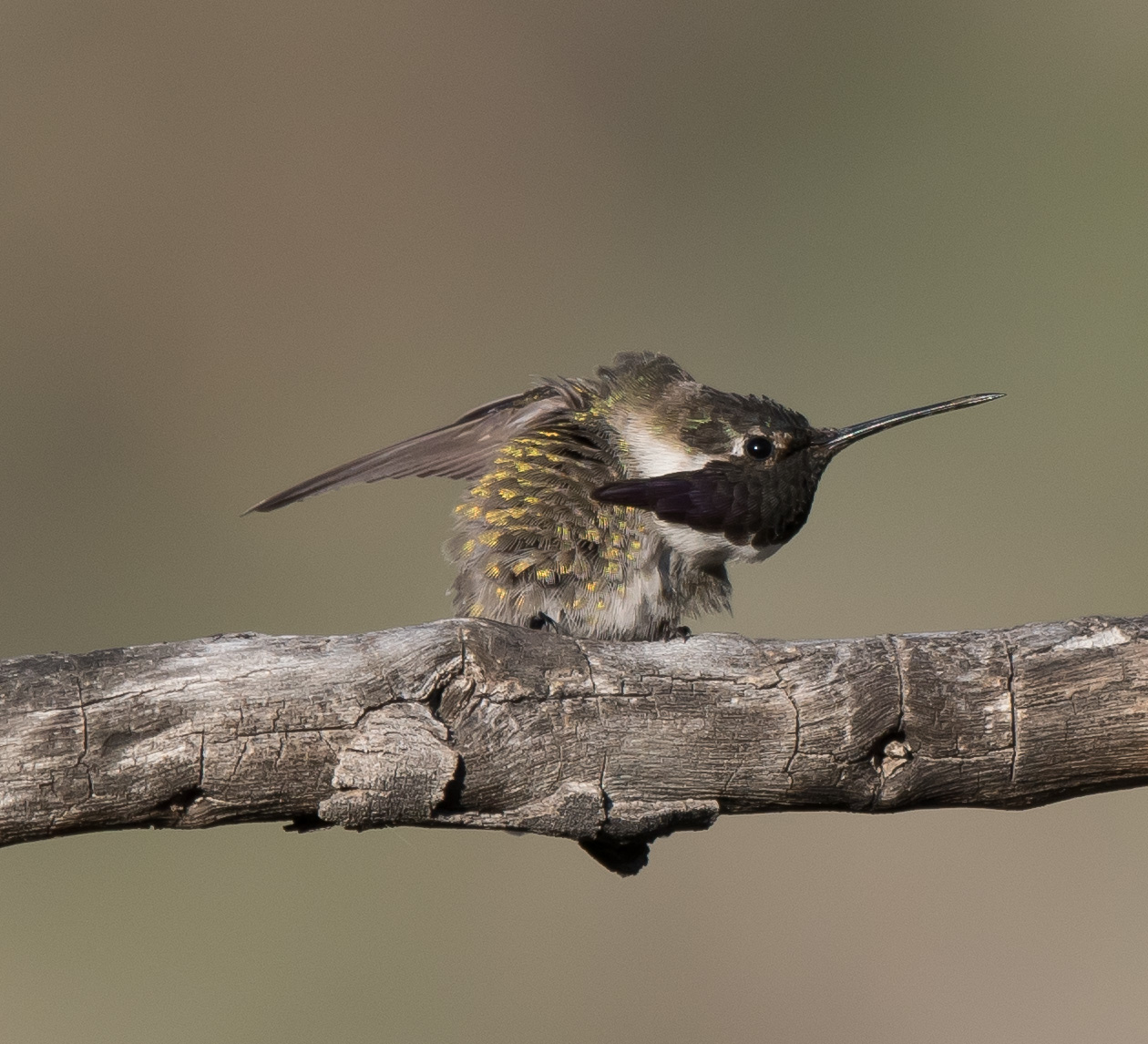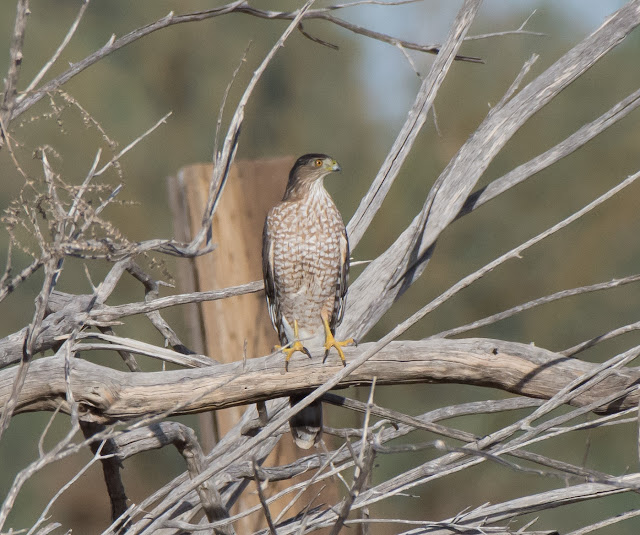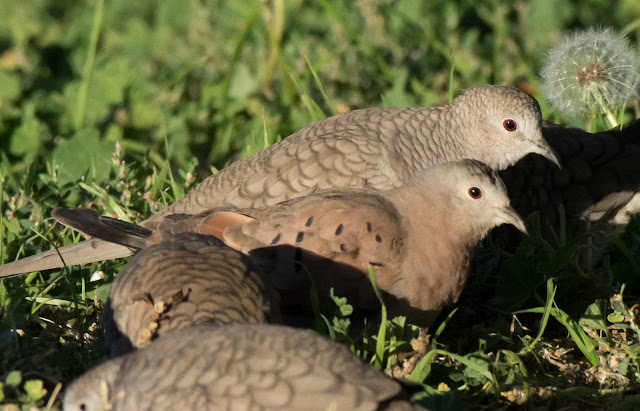If you are a birder, you already know what a Big Year is all about. However, for those readers that are not sure, a Big Year is a commitment from a birder to try and list as many species of birds that one can find within a calendar year in a selected location. That person can set their parameters on various things such as geographic limitations, species or families of birds, etc. Since I retired about a year ago, I decided that I would try to complete a Maricopa County Big Year, thinking I would have more free time on my hands. Prior to 2016, the highest number of species reported in 1 year in Maricopa County was 313 and was accomplished in 2011, by good friend Tommy DeBardeleben.
Prior to 2016. my best count was 246 species in Maricopa County for a year. With that number in mind, I set a goal of 275, maybe 280, for the year as that would be quite an increase for me. What's more, is the fact that I only wanted to count ABA countable birds and not the exotics that are sometimes found and counted by many others. These exotics include birds that are most likely escapees from bird collections or birds that have been brought in to a community but have not established themselves as a viable breeding population in the county and are not native to the county. Most of these exotics that were reported by others during the year, but not by Tommy or me, were Mute Swan, Mandarin Duck, Yellow-collared Lovebird, Nanday Parakeet and Monk Parakeet. Although, I did see most of these birds during the year, I did not add them to my Big Year list.
I had a lot of encouragement from a few people. A couple of them, Tommy DeBardeleben and Caleb Strand, were confident I could conceivably hit the 300 mark. I was a bit doubtful of that number, but kept pushing on through the year, and believe it or not, I did hit the magical 300 number and then some. My final total count was
312; not a county record, but still a number I can be proud of for the time being. Previous county record was Tommy at 313, but he shattered that record this year at 330! So I am pleased with currently having the 3rd highest total, but I also know that records are meant to be broken, so I know it will some day be surpassed.
One needs to bear in mind that Maricopa County is a large county in geographic area. In fact it is the 15th largest county in the United States, and larger than 4 of the US states. While it is not on the scale of an Arizona state big year, it still requires traveling a lot of miles to many spots where the birds can be found, and sometimes, it takes more than just one trip to finally find the bird that is being reported.
The above graphic is courtesy of Wikipedia.
~~~~~~~~~~~~~~~~~~~~~~~~~~~~~~~~~~~~~~~~~~~~~~~~~~~~~~~~~~~~
Now lets move on to some of the highlights of the year. My 246th bird of the year, which tied my previous record, was a Spotted Owl on April 29. Great bird for the tie, and new bird that I had never recorded before in Maricopa County. This species is endangered and protected and can be hard to find.
Number 255 was one of the more colorful birds, a stunning male Painted Bunting, that I was able to photograph at Tres Rios Overflow Wetlands on May 7.
On May 21, I made a trip to Hassayampa River Preserve to look for a Thick-billed Kingbird that had been reported. This was also a new county bird for me as well.
In mid July, 2 species of rare birds were found in the county and the day that they were spotted and posted, I happened to be in Madera Canyon and heading to Sonora, Mexico, the next day, and I was a bit frustrated to miss out on these 2 species. I knew that the Black Skimmers that were found would not stick around as the habitat is not suitable to them. The other bird was a Hudsonian Godwit (#264) which is even rarer and surprisingly it was still here about a week after I returned. I was able to add this bird to my list and my 'life' list a well on July 20. It was on private property and was a bit distant, so the photo opportunity left a little to be desired, but who cares when it is a life bird and a county bird!
A visit to Mt Ord on August 24th netted me my 274th bird, a Calliope Hummingbird. This was another bird that I had not seen in Maricopa County in the past, and the sighting was even more special since I found it on my own and was not chasing someone else's report.
Number 275 was a another bird that I was out of of the county when it was reported. I was on a birding trip to the White Mountains in eastern Arizona with birding friends, Muriel, Babs, and Chris, when a Tricolored Heron was reported at the Gilbert Water Ranch. It seemed to be a long ride home, but we got back in time on August 28th to locate it. Really did not have to hurry as this bird remained at this location for weeks.

Bird number 277, was a bird that I do not think anyone in the state even had it on their radar as a possibility of showing up in Arizona, let alone Maricopa County. On 7 September, Hurricane Newton, moved into the state from the Pacific Ocean by the way of the Gulf of California and it broke apart south of Tucson. It brought with it many pelagic (sea) birds that rarely see land. While the greatest number were reported in southern Arizona, one remarkable one made it as far as Mesa and found a city pond to reside on just a few minutes from my house. Wedge-rumped Storm-Petrel was not only a new bird for the state of Arizona but obviously one for Maricopa County as well. It was a life bird for myself and dozens more that made it out to visit it on that special day.



Number 280, which was my original target number, was a Clay-colored Sparrow, a bird that eluded me over the years in Arizona and Maricopa County. Added this one on September 27 and followed up that bird a few day later on October 2 with a Long-eared Owl (#282).
Number 287, was also a life bird for me in the county, a Lapland Longspur on October 11. The bird gods must have felt sorry for me as this bird landed on a dirt bank about 10 yards from my car, just as I was thinking of leaving.
4 days later, on October 15, Tyler Loomis discovered a Palm Warbler at Tempe Town Lake. This would be a 'lifer' for me as well and I rushed out to see it briefly in the fading daylight. The next morning I went back to relocate it and got much better views and much better photos.
Incredibly, in November a Groove-billed Ani was found at Veteran's Oasis Park in Chandler. This was another totally unexpected bird to make its appearance in the county. I was out there the next day to locate it and add to my list for the year. This was number 297 on November 17, and I was knocking on the door on that magical 300 number.
A trip to Slate Creek Divide with good friend Tommy, on November 23, got me 4 new species that pushed me over the 300 mark. Number 300 was a Mountain Chickadee. The next day was Thanksgiving day and I followed up on report of a Ruddy Ground-Dove (#303) in Tempe which was not far from my house. I was able to locate it and was able to wait around until Tommy was also able to get there and add it to his list as well.
Number 304 was a handsome looking Harris's Sparrow on November 27 in the back yard of Jack Sheldon, who graciously allowed Tommy, Barb Meding and myself to peek over his back yard fence to see it and photograph it.
A Tundra Swan was number 305 at a pond at a golf course in Sun City West on December 4.
Number 306 was a Ross's Goose on the same day in the Buckeye/Arlington area. The next day I traveled to Seven Spring Wash to try and locate a Hooded Warbler that had been reported by Troy Corman 2 days earlier and re-found by Tommy the day before. Tough bird to photograph, but quite a stunner, so a bad photo is better than no photo of this bird. Number 307 was in the books.
Number 308 was a Long-tailed Duck that showed up at the Glendale Recharge Ponds on December 11. To my knowledge it is still there, which is very remarkable.
A Louisiana Waterthrush (#309) was discovered on the Salt/Verde CBC on December 14 and Tommy and I was there early the next morning, December 15th to look for it. This is a great bird and one that I had only gotten a brief look at in the past near Tucson. But this time I got better looks and also photos of a species that is rare for Arizona.
On December 21 Tommy asked me to join him to travel to a remote corner of Maricopa County to try to locate a Rufous-winged Sparrow. This is a bird that is fairly common in the correct habitats in southeastern Arizona, but almost unheard of in Maricopa County. We had success in finding this bird and it came in on my list at number 310.
Tommy had reported a pair of White-tailed Kites in the Buckeye area on 22 December, so I headed out there the next day and was joined by Caleb Strand. Caleb was quick to find one in his scope and get me on it and later we got to see both of them 'kiting' about the fields. That was number 311 for the year.
My final bird for the year, #312, was a Pacific Wren on December 28. I returned to Seven Springs Wash, where the Hooded Warbler was hanging out. Tommy had a reported a Pacific Wren there on his original trip, but I had dipped on it when I went the first time. Since this is a bird that kind of stays put for the winter, I knew there was a good chance it was still there. This time, luck was on my side when it called out and I instantly recognized its call. When it came out into the clear, it gave me lots of good looks and chances for photos.



Taking on a Big Year was a great learning experience for me. I knew going in that I would have dedicate most of my time to chase every rare or uncommon bird that was reported. It is a very time consuming endeavor and many came at the most inopportune time. Even when chasing, many chases ended up fruitless and were very disappointing and frustrating. A good example is chasing the Franklin's Gulls that were being reported on Tempe Town Lake. It took me 5 trips to finally find one, only to find a flock of 15 of them about 2 weeks later at Glendale Recharge Ponds. But more often than not, the chases ended in success and when they did the experience was quite exhilarating. During the year I was able to add 5 new lifers to my life list which is quite an accomplishment for a county in the middle of the state. And even more astounding, I added 30 new species of birds to my Maricopa life list!
Must close by mentioning that Tommy was a motivational person in my quest and he offered a lot of encouragement along the way. Mr Caleb, was also instrumental in assisting many times and also felt that I had a chance to break the 300 mark. Being able to document more than 300 species, excluding all the exotics, is not an easy task in Maricopa County. Anyone wanting to attempt this in the future has my full support and well wishes! As for me, I will probably not complete another Big Year unless it is a small one with very limited parameters such as a 'patch' or specific location.
































































